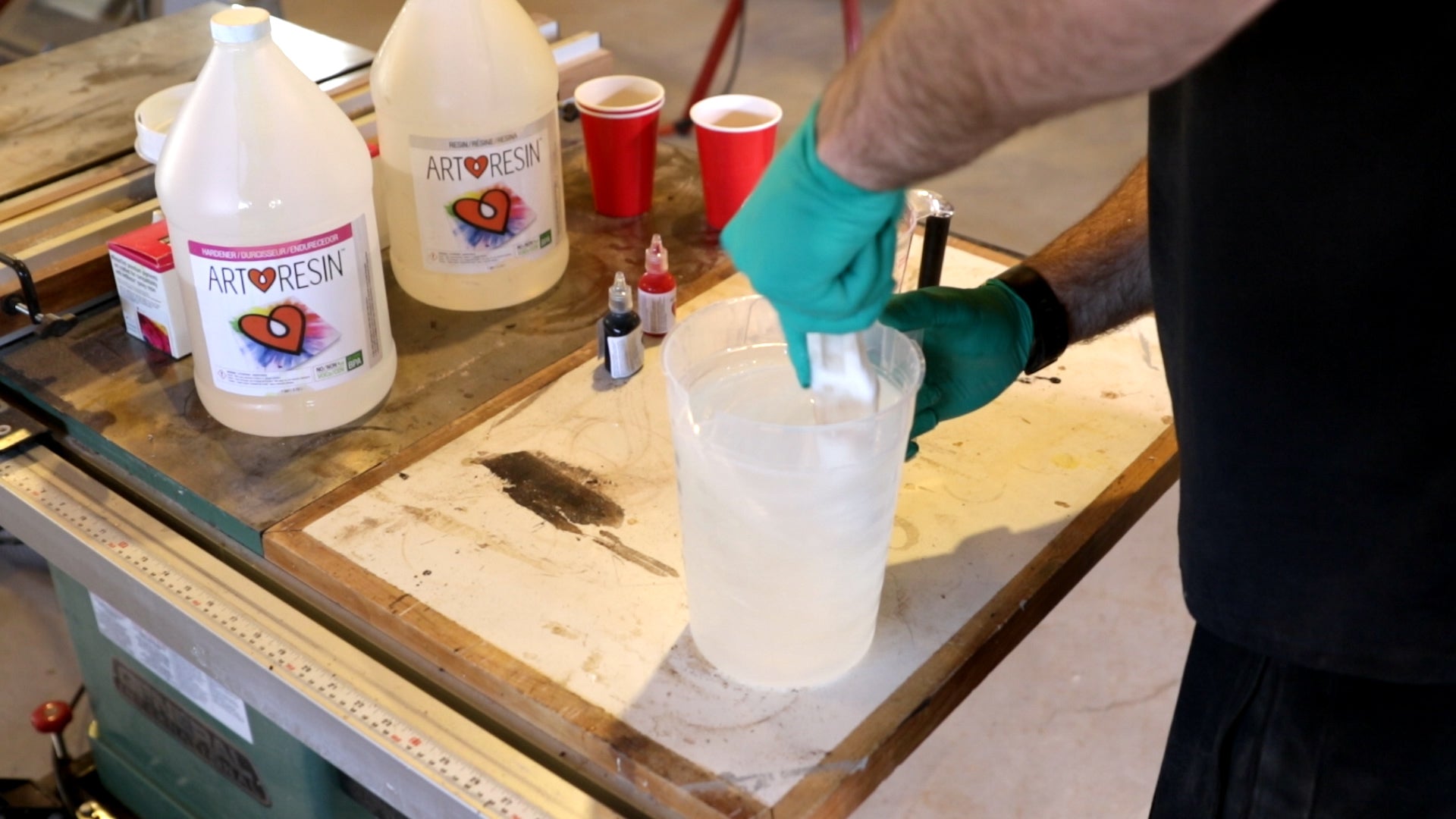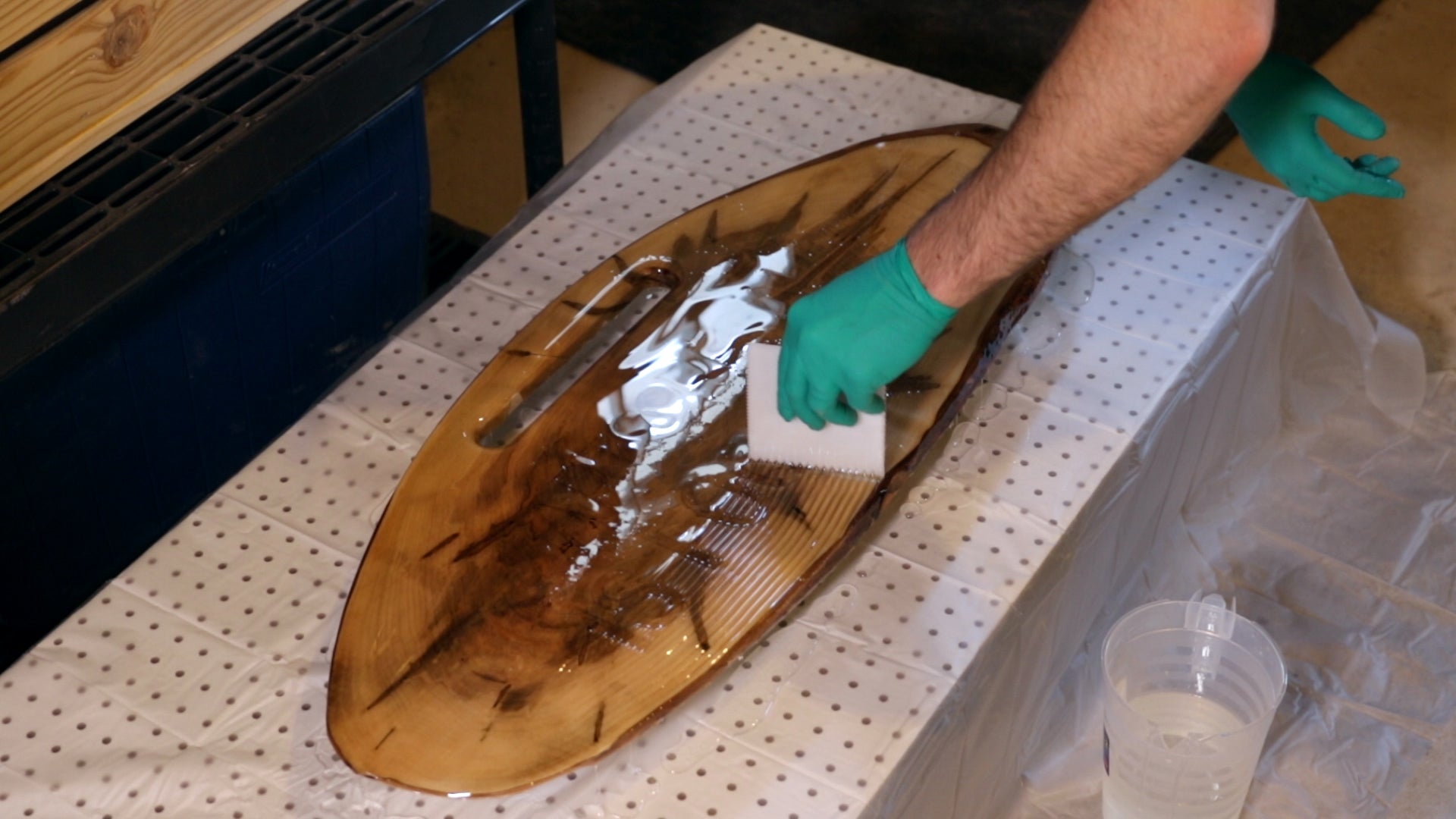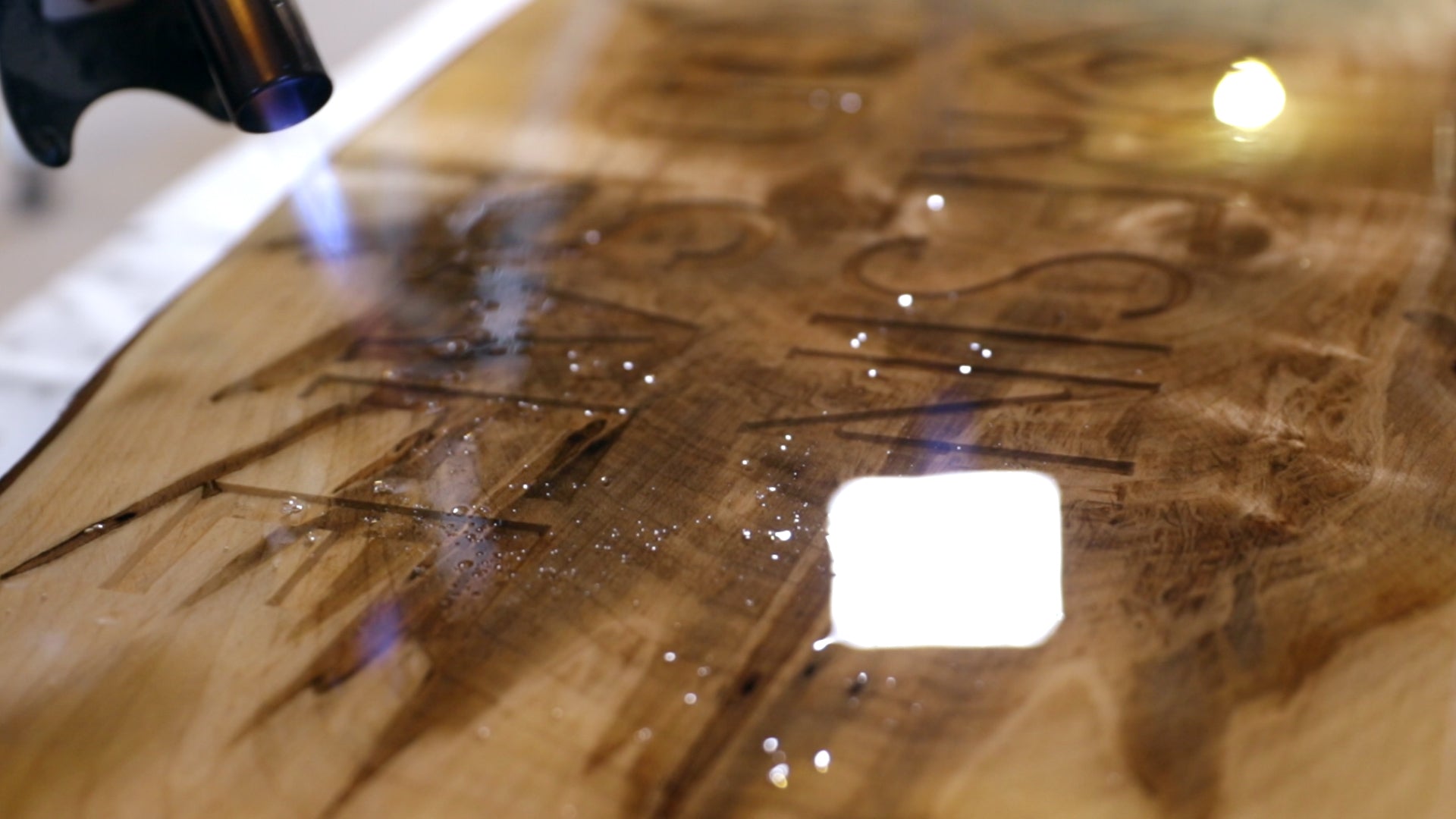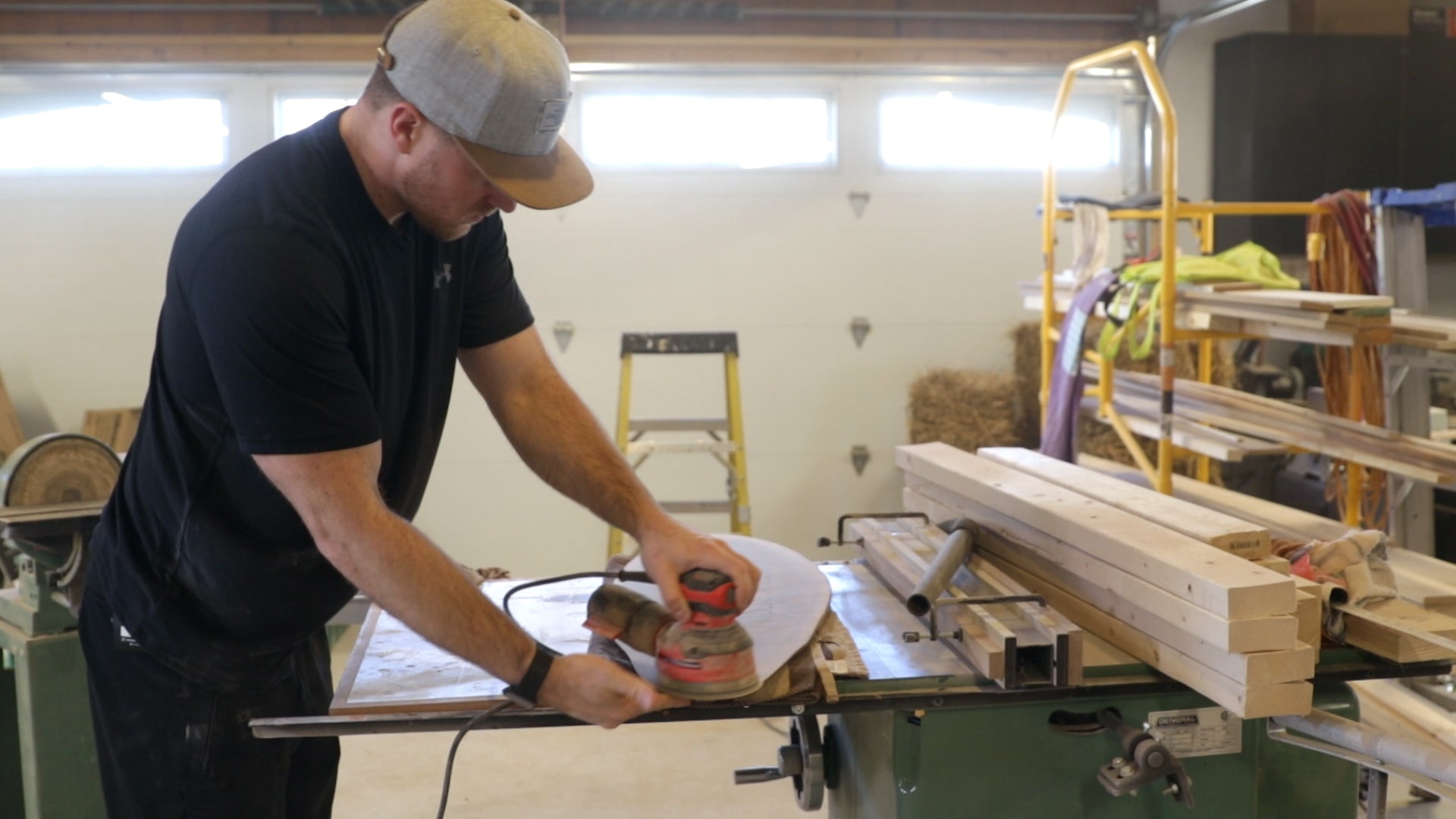It's easy to see why charcuterie boards are so popular with those who love to entertain! A charcuterie platter is a show-stopper that's simple to prepare, delivering big on both flavour and looks, especially when you have a gorgeous piece of wood as your starting point.
Making your own one-of-a-kind epoxy resin charcuterie wood board is easier than you think! Woodworking artist Jordan Codack of Codack Classics is here to show us, step-by-step, just how simple it is to transform a slice of wood into a functional, charcuterie board, with either a high-gloss or a matte finish.
Let's take a closer look ...
Choose Your Wood
Select a board that you love: we prefer durable, hard woods like walnut, maple, cherry, or ash, cut in a cross section slab with the live edge still visible, but there's no right or wrong here. Choose a piece of wood that speaks to you, in a size that works best for you, with a grain and colour that you love. If you use wood with the bark still attached, a coat of ArtResin is a great way to protect it for the longterm, ensuring it stays intact and doesn't break down ( or break off ) over time.
- Ensure your wood is thoroughly dry: if you resin over wood with too much moisture in it, you will have an issue with the wood expanding and contracting with the weather, which could cause the resin to crack. For peace of mind, we prefer getting kiln dried wood from a wood supplier.
- Incorporate a design: you can, as Jordan did, use a CNC router to carve out an image or lettering, or you can choose a piece of wood that already has a natural hole to fill in with resin. You can even paint a design directly onto the wood using acrylic paint, or simply resin the wood as is.
💡 A Note On Sealing: being an organic material, wood may contain trapped air which can release into your resin as bubbles. There are many variables that can affect gas bubbles: the type of wood, how dry the wood is, humidity etc. You may need to sand down the resin and re-apply if your wood off-gasses as the resin is curing. If your wood is prone to off-gassing, sealing wood with a brush-on sealant ( allowing it to thoroughly dry before resining ) is a good option to help prevent bubbles.
Read our blog on sealing before applying resin.
1. How to Make a Resin Charcuterie Board with Gloss Finish

What You'll Need
- a piece of wood
- ArtResin epoxy resin
- nitrile gloves
- a level, like ArtResin's phone level
- a measuring cup with easy to read measurement lines
- a mixing container
- a stir stick
- a spreader or popsicle stick
- a handheld torch like our Artist's Torch
- toothpicks
- an empty plastic tote or cardboard box with the flaps cut off to protect your piece while it dries
Browse our resin art tools & accessories!
1. Prep your space
Lay a plastic drop sheet or shower curtain over your work surface. Prop your wood up on stands and ensure it's level. Make sure your dust cover box is close by. 
2. Measure accurately ( by volume ) precisely equal amounts of resin and hardener
Stir thoroughly for 3 minutes total, ensuring you scrape the bottom and sides of your mixing container as you go.
💡 TIP: determine how much ArtResin you'll need by entering the length and width of your piece into our Resin Calculator

3. Pour and spread the ArtResin onto the centre of your board
Spread it out to the edges using a plastic spreader or a popsicle stick. You'll have about 45 minutes of working time before the resin gets too thick to work with.
💡TIP: Read our blog How To Pour And Spread Epoxy Resin for more resin tips and techniques!


4. Torch out the bubbles using an Artist’s Torch
Hold the flame a couple of inches above the resin surface, keeping the torch moving from side to side at all times. Once the piece has been torched, look at the resin in the light for any missed bubbles, tiny hairs or bits of dust, using a toothpick to fish them out.
💡TIP: Read our blog with all you need to know about How To Use A Torch On Epoxy Resin.
5. Cover your piece to protect it from dust
Place a plastic tote or a cardboard box ( with the flaps cut off ) over your piece and let it sit for 24 hrs until it’s dry to the touch. When it's dry, you can sand down any drips from the back of your piece.
💡TIP: Tape off the bottom of your piece using good quality painter's tape before you resin. The next day, simply pull off the tape and the drips right along with it!

2. How to Make A Resin Charcuterie Board with Matte Finish

What You'll Need
- a piece of wood
- ArtResin epoxy resin
- ResinTint liquid colorants
- nitrile gloves
- a level, like ArtResin's phone level
- a measuring cup with easy to read measurement lines
- mixing containers, one for each resin colour
- a stir stick
- a spreader or popsicle stick
- a handheld torch like our Artist's Torch
- toothpicks
- an empty plastic tote or cardboard box with the flaps cut off to protect your piece while it dries
- sandpaper in a variety of grits: 80, 120, 240, 400, 600, 1000
- wet cloth for wiping down the board in between sanding
Check out our blog: How Much ArtResin Do I Need?
1. Prep your space
Lay a plastic drop sheet or shower curtain over your work surface. Prop your wood up on stands and ensure it's level. Make sure your dust cover box is close by.

2. Measure accurately ( by volume ) precisely equal amounts of resin and hardener
Stir thoroughly for 3 minutes total, ensuring you scrape the bottom and sides of your mixing container as you go.
💡 TIP: for our very best measuring and mixing tips, read the blog How To Measure And Mix Resin And Hardener.
3. Tint your resin
Use a separate plastic cup for each colour.
💡TIP: When adding colorant to epoxy resin, be careful not to add more than 6% of the total combined volume of resin and hardener, or else your resin may not cure properly. For example, 100 ml of resin and hardener combined will allow for a maximum of 6 ml of colorant. ResinTint are highly pigmented so it's likely you will not need that much.

3. Fill in the carved areas
Slowly and carefully pour the tinted ArtResin into the carved areas of your board until they are ever so slightly overflowing. You can overfill since you'll be sanding down the excess resin, but keep in mind that the more you overfill, the more you'll have to sand off. You'll have about 45 minutes of working time before the resin gets too thick to work with.
💡 TIP: If you're filling a natural crevice or hole in the wood, ensure you tape off the hole on the bottom of the board to prevent the resin from seeping out underneath. We like using a good quality painter's tape or a sheathing tape (found in the insulation section of your hardware store.)
5. Torch out the bubbles using an Artist’s Torch
Hold the flame a couple of inches above the resin surface, keeping the torch moving from side to side at all times. Once the piece has been torched, look at the resin in the light for any missed bubbles, tiny hairs or bits of dust, using a toothpick to fish them out.
💡 TIP: Read our blog with all you need to know about How To Use A Torch On Epoxy Resin.

6. Cover your piece to protect it from dust
Place a plastic tote or a cardboard box ( with the flaps cut off ) over your piece and let it sit for 24 hrs until it’s dry to the touch. When it's dry, you can sand down any drips from the back of your piece.
💡TIP: Tape off the bottom of your piece using good quality painter's tape before you resin. The next day, simply pull off the tape and the drips right along with it!

7. Sand
Using an electric sander, start first with a coarse sandpaper like 80 grit to clean up the excess resin and to ensure the resin and wood are perfectly level. Next, wipe down the board with your wet cloth to raise the grain and allow the board to dry, approximately 10-15 minutes.
Next, sand with 120 grit, and wipe down with a wet cloth. Repeat this process with 220 grit and 400 grit sandpaper, wiping down and allowing to dry in between each sanding.
Last, sand down with 600 and 1000 grit sandpaper to polish the board and make it buttery smooth - there's no need to wet the board in between these higher grits.

8. Oil and condition the board
When the board is perfectly smooth, you will apply a non-toxic, food safe oil (like mineral oil), allowing it to soak into the board and absorb. Wipe off any excess oil, then apply a non-toxic, food safe wood conditioning wax ( Jordan's wax was beeswax and mineral oil based.) This wax needs to be applied approximately every month. 


So there you have it!
Whether you choose matte or shiny, both epoxy charcuterie boards are:
✅ gorgeous.
✅ going to steal the show at your next dinner party!
From start to finish, ArtResin allows you to get creative. Now you can create your own resin charcuterie board!
Want more resin art project ideas? See our how-to tutorials.
- Is Epoxy Food Safe?
- Is ArtResin Food Safe?
- ArtResin Epoxy Resin Passes Food Safety Tests
- Can I Use ArtResin To Make Coasters And Hot Plates?
ArtResin: Made For Artists, By Artists.



